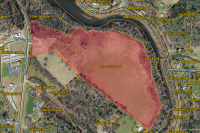Exploding waterfowl population prompts feeding ban at Lake Junaluska
 As the first chunk of bread was tossed in the air, a swarm of ducks and geese at Lake Junaluska swiftly waddled toward the source of the handout, a chorus of quacks and honks rising up from the flurry of feathers.
As the first chunk of bread was tossed in the air, a swarm of ducks and geese at Lake Junaluska swiftly waddled toward the source of the handout, a chorus of quacks and honks rising up from the flurry of feathers.
Sometimes, it is just a handful of waterfowl, but more often, dozens of ducks and geese crowd toward the feeder, fighting for a nibble, much to the delight of the bread bearers.
Feeding the ducks and geese at Lake Junaluska has been a tradition for visitors and residents alike for decades. Lake residents likewise partake in the pastime, and are often seen walking the shoreline with a bag of white bread in one hand and a grandchild’s hand in the other. Locals make as regular outing of it as well — packing their kids in the car, picking up a cheap loaf of bread and staking out the optimum location for feeding.
But effective this month, Lake Junaluska will no longer allow anyone to feed the hundreds of waterfowl, whose excrement, aggressive behavior and year-round nesting have continued to cause problems for more than a decade.
“If the food stops, maybe they will migrate on,” said Buddy Young, director of Assembly Public Works at Lake Junaluska.
Related Items
Young said he is sorry that kids might be disappointed, but the fact is the waterfowl have become more than a nuisance.
“I know that it will sadden a lot of people and families and children, and I am sorry for that,” said Young, who remembers bringing his own son, who is now 30, to the lake to feed the waterfowl.
But, with the only apparent pro to feeding the waterfowl being the joy that it brings families — when compared to the long list of cons — it does not stand up. The lake this week is posting “no feeding” signs around the shore, and starting Sept. 17, it will being enforcing the new policy.
Amanda Franklin and her 5-year-old son Dustin Moore were feeding the ducks at Lake Junaluska on a late summer evening last week, unaware of the duck-feeding ban about to go into place.
Like so many who grew up in Haywood County, feeding the ducks at Lake Junaluska was a memorable part of Franklin’s childhood.
“My parents would bring us every Sunday,” Franklin said.
Franklin started bringing her own son when he was 3 and still remembers the happiness in his face the first time he tossed bread morsels to the eager, quacking ducks.
“It was so fun to watch him,” Franklin said. “It was passing on something that I had grown up with.”
Feeding the ducks is a weekly activity for Franklin and her son, even more in the summer. It is also a social occasion. There are few evenings where she doesn’t run into people she knows along the lakeshore.
For Andy Curless, a longtime and loyal visitor to the lake, feeding the ducks is a ubiquitous pastime during his twice-annual family vacations here. Both his parents are Methodist ministers and have been making the pilgrimages to Lake Junaluska his entire life.
“Every time — there’s not been a year I haven’t fed the ducks,” said Curless, 40, admitting that the tradition continued even as a grown man before having children of his own to share the experience with.
Left with no choice
The decision by Lake Junaluska Assmebly to ban feeding of ducks and geese was not made quickly — not after a few months or even a few years.
“It has been discussed for the whole 12 years I have been working here,” Young said. “It was not a decision made lightly.”
The waterfowl population had grown so larger, fueled in part by the feeding, that the unpleasant side-effects of poop, feathers, smell and a denuded shoreline finally forced the Assembly’s hand.
Area naturalists were happy to hear that the lake was finally taking action.
“It’s long overdue,” said Michael Skinner, a naturalist at the Balsam Mountain Trust’s Nature Center. “It is nothing but a good idea in my opinion.”
Without any action, the population would continue to grow, and so would the piles of poo.
“I think it is just something that had to be done. The population was getting out of hand,” said Don Hendershot, a naturalist and professional birder in Waynesville.
Most residents of Lake Junaluska took the announcement of the no feeding policy well.
“It was very positive,” Young said. “I had several people saying ‘Thank goodness, it’s about time.’”
Homeowners are the ones who see first-hand how the large waterfowl population affects life around the lake, Young said, and were often the ones who complained about them.
“They are here; they see it,” Young said.
Those same families who supply the ducks and geese with food must play hopscotch over and around the heaps of feces the geese leave behind on the shoreline and walking path around the lake. And, birds are notorious for spreading diseases, particularly when the population becomes overcrowded, Skinner said.
The droppings as well as over-grazing of the lakeside grass have also damaged the shoreline.
As sad as Curless is to see the feeding end, he said he understands the concern. The duck and geese population is easily twice what it use to be, he said.
“The heartstrings go both ways,” Curless said. “I can understand it.”
Because the waterfowl have lost their fear of humans, they can be aggressive. While no one has been seriously injured at Lake Junaluska, Young said that the possibility is a concern. The animals are eye-level with, and in some cases taller than, the young children who enjoy watching the birds battle for scraps of bread.
“We have had kids scared and intimidated,” Young said.
An unnatural population
While the snowbirds head to Florida for the winter, hundreds of geese and ducks overwinter at Lake Junaluska, Young estimated. And, providing them with something to eat during those cold months only keeps them around.
“The feeding exacerbates the problem,” he said.
Waterfowl specifically lose the instinct to migrate. Why move when a location offers a consistent food source?
“They are all basically domestic birds,” Hendershot said. “They have no migration instinct.”
In the wild, nature balances life on its own. The population of waterfowl will only grow as large as what the habitat can support. Meaning if there is only enough food and shelter for 40 birds, then the population will hover around that number. Others will move on to places where more sustenance is available.
By feeding the ducks and geese, people are messing with nature, which has led to a surge in the numbers of waterfowl who call Lake Junaluska home.
“By having an unnatural food source, you will create an unnatural population,” Skinner said.
And, although people mean well, their food of choice — white bread — is like candy for birds.
“It’s just not nutritious,” Hendershot said.
Birds need protein and other nutrients in their diet to help develop their muscles and feathers. Store-bought bread has very little nutritional value, is processed and is not a natural part of their diet. Ducks and geese are usually herbivores.
“It’s not their natural food,” Young said. “It is easy food. They don’t work for it.”
If waterfowl are fed bread too often, they become malnourished and obese, and if they become dependent on it as their main food source, then they will have trouble surviving without it.
Bill King, chair of the Lake Junaluska Community Council, compared the waterfowl situation to people feeding the bears in the Smokies when he was a child.
Bears would troll the roads, waiting for people to stop their cars and feed them, creating massive traffic back-ups. The phenomenon was so prevalent that it had its own name — a bear jam.
Wildlife experts had to educate people on the problems that feeding the bears caused.
“We are now very accustomed to the fact that you don’t feed the bears,” King said.
Although a duck or goose is not likely to seriously injure someone like a bear might, feeding any feral animal domesticates it. The animals no longer fears humans, and they can actually lose instincts that are critical to their survival in the wild, such as how to catch prey.
One thing that is not yet clear is whether the ducks and geese that have become so domesticated will be able to survive once the human hand-outs come to an end.
A common problem
The problem is not just at Lake Junaluska, however. A search of “geese problems” will bring up news stories and government websites about how to deal with a glut of waterfowl overrunning man-made lakes, particular in residential communities where people are prone to fee them.
“The geese — that is a problem all across the Southeast,” Hendershot said.
In the 1960s and ‘70s, there was a drop in the Canada geese population. In an attempt to rebuild it in the U.S., officials brought gaggles to the South and, for the next few generations, clipped their wings to make them stay put, Hendershot said. By the time wildlife officials had stopped, the geese had lost their migration instinct.
The Canada geese are protected by the Federal Migratory Bird Act, which prevents people from killing or otherwise harming the geese without a hunting permit.
The special permit — known as a depridation permit — is designed for instances just like this, where waterfowl are damaging property.
In the past, Lake Junaluska received a special license to kill the waterfowl from the N.C. Wildlife Commission, but never pulled the trigger so to speak.
“The first thing that every site tells you is to stop the feeding,” Young said. “As unpopular as this is going to be, it is not going to be anything like if we started taking them out.”
Lake Junaluska does not have the permit anymore, but Young did not rule it out as an option if the population does not dwindle following implementation of the new policy. Assembly leaders hope to see the waterfowl population start to decline this winter, Young said.
The no-feeding policy is not the first action Lake Junaluska has taken to corral the ducks and geese that fill the lake. Three years ago, the assembly bought a Border collie. The dog lives at the lake and is trained to act like a predator, stalking the waterfowl and trying to keep them off the paved walkway and other parts of the shore.
But, the collie has not been able to keep the waterfowl contained to the lake with people consistently drawing them onto the lakeshore to feed them.
“She has had some very limited success, in a big way because of this situation,” Young said.
Not all the waterfowl at Lake Junaluska will be singing a swan song, however, as they either move on or die off.
The lake’s new “no feeding” policy does not apply to the small swan population that inhabits the area. A group of residents built a couple small fenced-in enclosures where they feed the lake’s four swans.
“Swans are not the problem,” Young said. “(The homeowners) keep their food under lock and key.”
By locking up the food, the residents can more easily monitor when, how much and what the swans are fed. Unlike the ducks and geese, it has not led to an influx of swans to the lake.
Sherri Gillett wondered why the same could not be done for the ducks and geese.
Gillett, who grew up feeding the ducks at Lake Junaluska, doesn’t understand the need for the new policy. If the poop and feathers littering the lakeshore are the concern, why not create a designated feeding area?
The lake could build a dock where people can feed them out over the water. That would keep the ducks and geese from coming up on shore, Gillett said. Or, Lake Junaluska could simply designate the existing wooden footbridge as a feeding zone.
“I hope they can work something out so we can still feed them,” Gillett said.
Lake leaders had discussed dedicating a set area to duck and goose feeding but quickly realized that it would not help control the waterfowl population.
“There is not middle ground with the geese and ducks,” Young said. “Wherever we did it, they would just overwhelm it.”









